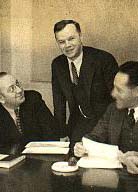 Elmer William Engstrom (August 25, 1901 - October 30, 1984) was an American engineer and corporate executive prominent for his role in the development of television.
Elmer William Engstrom (August 25, 1901 - October 30, 1984) was an American engineer and corporate executive prominent for his role in the development of television.
Engstrom was born in Minneapolis, Minnesota, and studied Electrical Engineering at the University of Minnesota. After graduation in 1923, he worked at the General Electric Company in Schenectady, New York, on radio technology and sound devices for motion pictures. When this activity was spun out to the Radio Corporation of America (RCA) in 1930, he took on further responsibilities for these technologies plus research in electron tubes.
During the 1930s, Engstrom led RCA's research and development efforts for television, culminating in the company's first commercial black and white television system. Its first complete test took place in 1939, with a transmitter installed on the eighty-fifth floor of the Empire State Building. A mechanical scanner provided a 120-line, 24-frame picture from live and film subjects, and extensive field tests took place with the first cathode ray tube receivers. Although picture quality was poor, the tests conclusively proved the feasibility of television broadcasting. This effort was one of the earliest applications of a "system engineering" approach, now standard practice on large technical programs.
Engstrom subsequently became head of RCA Laboratories (1943) and Vice President for research (1945), leading RCA's highly successful World War II efforts in radar, radio, and acoustics. In this role he led RCA's development of its first all-electronic color television system after the war ended, as well as national efforts including BMEWS (the Ballistic Missile Early Warning System) and the TIROS (Television Infrared Observation Satellite) weather-reporting satellite system. RCA's Astro-Electronics Division (1958) was the first organization within the electronics industry to develop space electronic systems.
Engstrom became RCA's President (1961-1965) and Chief Executive Officer (1966-1968), serving on its board until 1971. He served on numerous national advisory panels, was a founding member of the United States National Academy of Engineering, and received honorary degrees from eighteen colleges and universities including Drexel Institute of Technology, Findlay College, and New York University. He was an IEEE Fellow and received numerous awards, including the IEEE Founders Medal in 1966